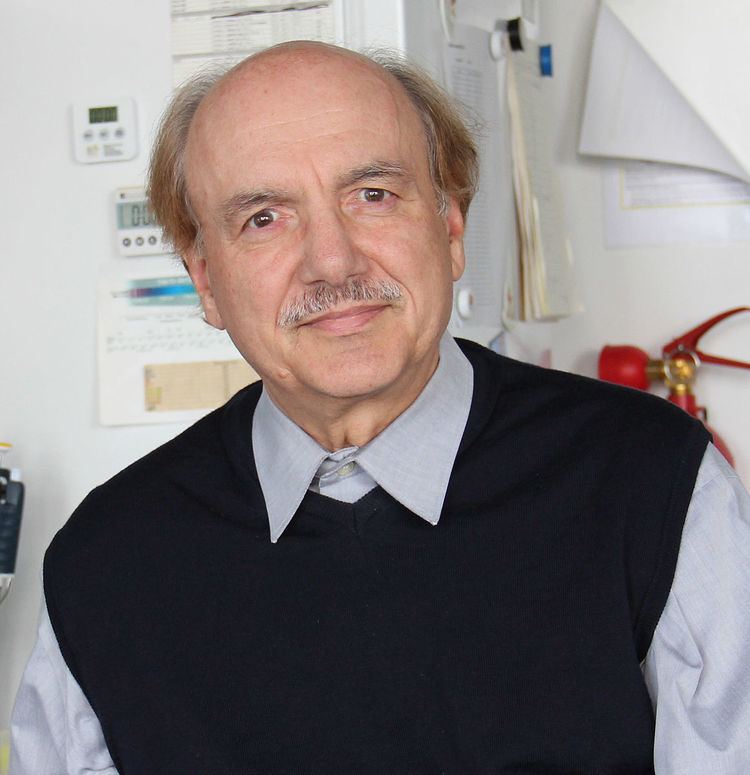Name Herbert Zimmermann | Role Neuroscientist | |
 | ||
Fields Neurobiochemistry, Synaptic Transmission and Purinergic Signalling Known for Characterization of the biochemical and structural heterogeneity of synaptic vesicle pools and the biochemical and molecular characterization of ectonucleotidases Books Greek Word-building, Synaptic transmission People also search for Norbert Elsner, Eberhard Hermes, Georg Kreutzberg | ||
Herbert Zimmermann (born 10 January 1944) is a German neuroscientist who pioneered the studies on the biochemical, structural and functional heterogeneity of cholinergic synaptic vesicles from the electric organ of the electric ray Torpedo, and the functional and biochemical characterization of enzymes hydrolyzing extracellular nucleotides.
Contents
Biography
Herbert Zimmermann was born in Chiesch (now Chyše, Czech Republic). He studied chemistry and biology at the Ludwig Maximilian University of Munich (1964–69) and obtained his PhD at the University of Regensburg in 1971. From 1972-73 he continued as postdoctoral fellow at the Department of Biochemistry at the University of Cambridge, UK. From 1973-79 he was scientist and senior scientist at the Department of Neurochemistry of the Max Planck Institute for Biophysical Chemistry in Göttingen (Germany). From 1980–83 he held the position of Professor of Neurobiology at the University of Oldenburg (Germany). In 1983 he was appointed chair and section leader of Neurochemistry at the Goethe University Frankfurt am Main (Germany). In 1987 he was visiting professor at the Institute of Brain Research of the Medical Faculty of the Tokyo University (Tokyo Daigaku). From 1991 to 1995 he was elected president of the German Neuroscience Society. 2008 he was elected president of the German Purine Club. After his retirement (2010) he continued as emeritus in the Department of Molecular and Cellular Neurobiology of the Goethe University.
Research
Zimmermann's initial studies in Munich and Regensburg under the supervision of Helmut Altner addressed a circumventricular organ specific for fishes, the saccus vasculosus. In Cambridge, in the laboratory of Victor P. Whittaker, he began his studies on the dynamics of the synaptic vesicle compartment. He used the electric ray electric organ that is homologous to the neuromuscular junction as a model system for cholinergic synaptic transmission. This system permitted parallel electrophysiological stimulation and recording and electron microscopic and in particular biochemical analysis of the outcome of the synaptic activation on the synaptic vesicle compartment. He showed that nerve stimulation induces both morphological and biochemical heterogeneity of synaptic vesicles. Vesicles that had gone through at least on cycle of exo- and endocytosis where reduced in size, could be separated by density centrifugation or chromatography on porous glass beads and were preferentially refilled with newly synthesized acetylcholine and ATP. This was in contrast to the reserve pool of synaptic vesicles that was not yet involved in the transmission process. The data suggested that synaptic activation induces synaptic vesicle heterogeneity whereby reloaded synaptic vesicles preferentially release newly synthesized acetylcholine and ATP. They provided a cell biological explanation for a previously unresolved problem in the earlier history of neurotransmission, namely that newly synthesized acetylcholine is preferentially released form stimulated nerve endings. He further showed that ATP released from the electric nerves is hydrolyzed extracellularly to adenosine that is recycled via a high affinity transport mechanism into the nerve terminals where it is rephosphorylated and taken up in the form of ATP into synaptic vesicles. Starting from the observation that ATP is hydrolyzed extracellularly he analyzed the biochemical pathways leading to the extracellular breakdown of released nucleotides to their respective nucleosides. This resulted in the isolation and molecular cloning of the AMP-hydrolyzing enzyme ecto-5'-nucleotidase as well as of a number of the nucleoside triphosphate and diphosphate-hydrolyzing enzymes of the family of the ectonucleoside triphosphate diphosphohydrolases. He also initiated a new nomenclature for these enzymes and for the ectopyrophosphatase/phosphodiesterases. More recently he analyzed the proteome of synaptic vesicles and the role of nucleotide signaling in the control of adult neurogenesis, the formation of new neurons in the adult mammalian brain.
